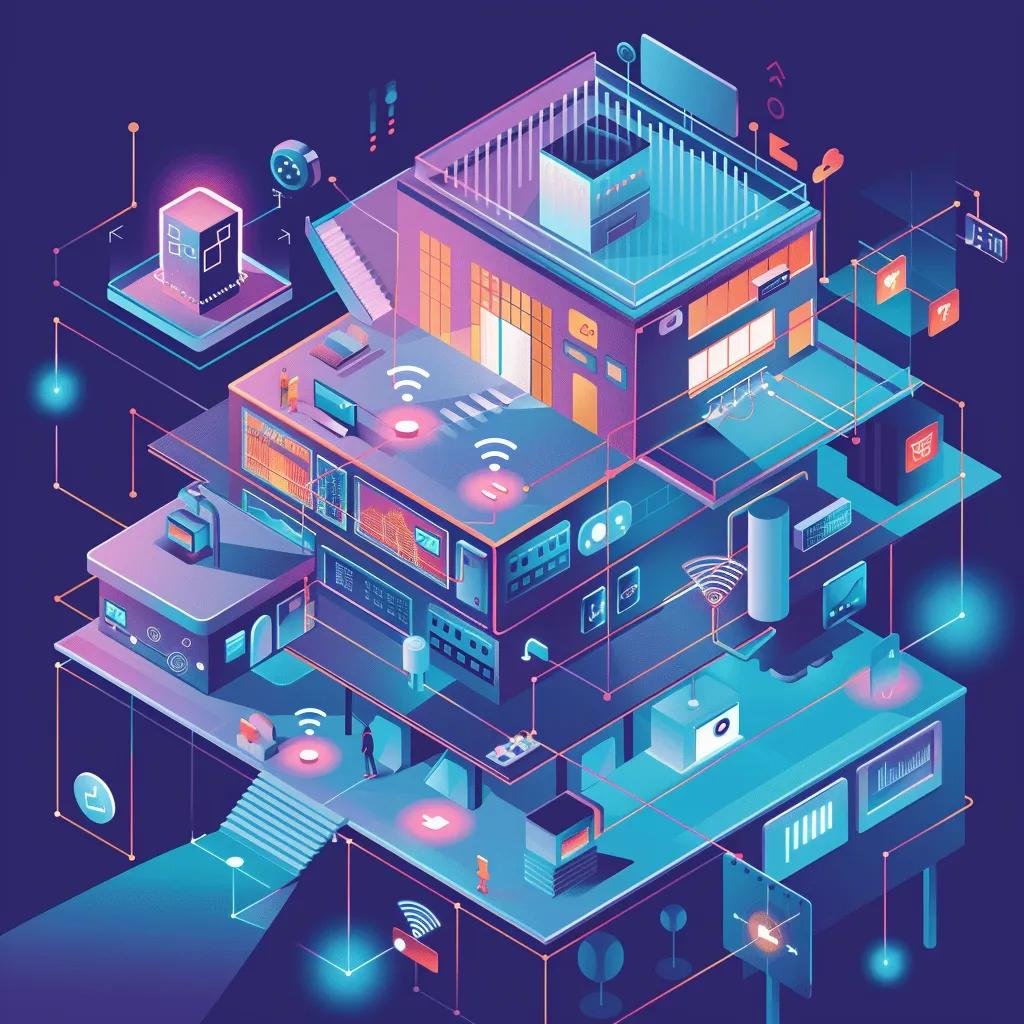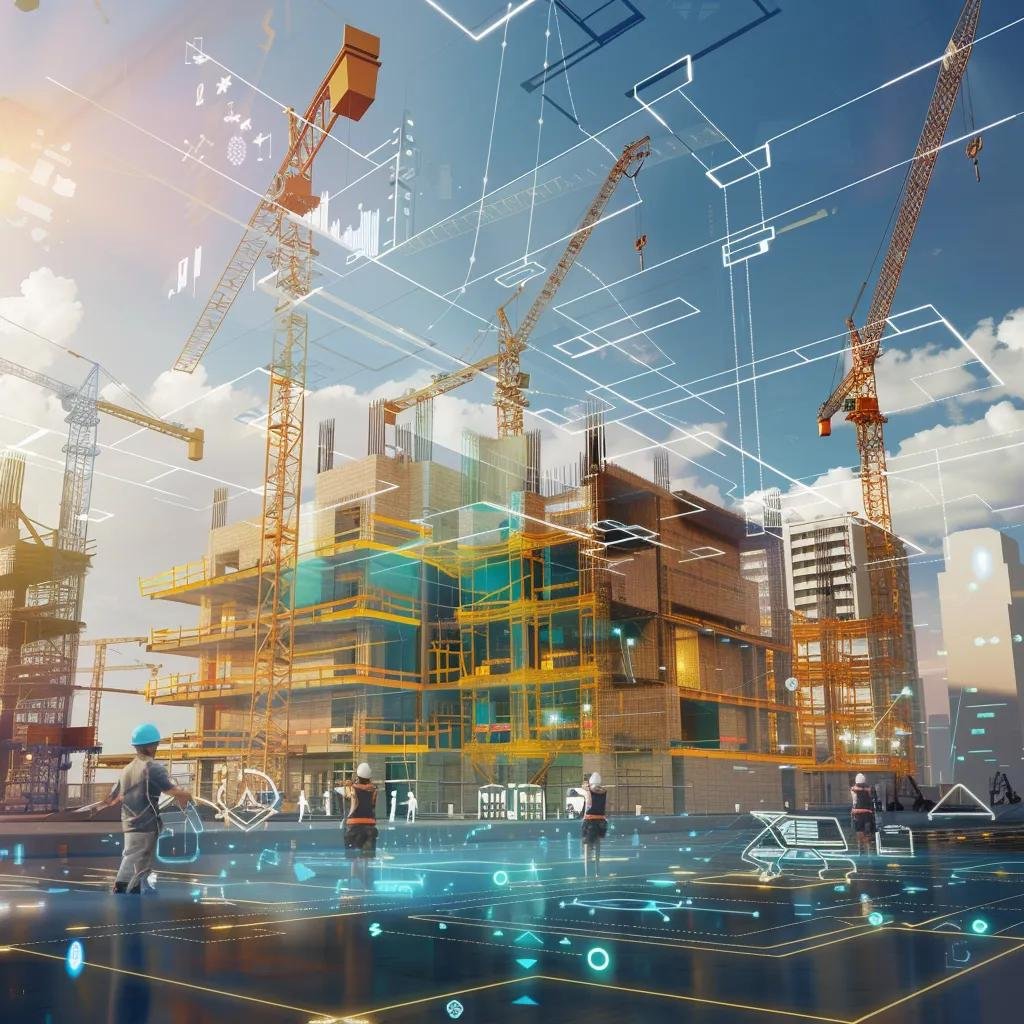Commercial Construction Industry Trends Shaping the Future: Key Innovations and Impacts for Businesses
The commercial construction industry is undergoing a transformation driven by smart technology, sustainability, health-focused design, modular methods and AI innovation—market drivers projected to boost global construction productivity by 20 percent by 2025. Businesses seeking to stay ahead must understand how these trends affect building performance, occupant well-being and maintenance needs. This article explores six pivotal trends—smart building systems, sustainable practices, modular construction, health-centric design, emerging challenges, and AI applications—and explains their implications for facility management, air duct cleaning and commercial cleaning services. Along the way, we highlight how Mastodon Marketing’s digital strategies support cleaning service providers in generating qualified local leads and maintaining industry authority.
Transforming Commercial Construction: Key 2023 Trends
Smart building technology integrates connected devices and analytics to optimize operations, reduce energy use and enhance occupant comfort. By combining Internet of Things (IoT) sensors, artificial intelligence (AI) platforms and advanced building management systems (BMS), property owners can monitor performance in real time and reduce maintenance costs. Understanding these innovations helps businesses plan for smarter facilities and anticipate new cleaning requirements.
Smart Building Technology and Energy Efficiency
Smart building technologies, including advanced building management systems (BMS) and IoT sensors, are designed to optimize building operations and reduce energy consumption. These systems provide real-time monitoring and automated controls, leading to improved operational efficiency and reduced maintenance costs.
This research supports the article’s claims about the benefits of smart building technologies.
How Does IoT Integration Enhance Smart Commercial Buildings?

IoT integration embeds sensors throughout a building’s infrastructure to collect data on temperature, occupancy, lighting and air quality, enabling automated adjustments that improve energy efficiency and occupant comfort. Key benefits include:
- Real-Time Monitoring: Continuous data from HVAC, lighting and security systems alerts facility managers to anomalies.
- Automated Controls: Occupancy sensors adjust lighting and temperature based on room usage.
- Data-Driven Insights: Analytics dashboards forecast energy peaks and maintenance needs.
These capabilities improve operational efficiency and set the stage for targeted commercial air duct cleaning services that maintain optimal HVAC performance, since sensor data often flags duct blockages or airflow irregularities.
In What Ways Is AI Transforming Building Management and Predictive Maintenance?
AI platforms analyze sensor data and historical performance to predict equipment failures before they occur, reducing downtime and extending asset lifespans. This involves machine learning algorithms that:
- Detect patterns of wear in motors and compressors
- Schedule maintenance when performance thresholds are crossed
- Optimize energy consumption by learning usage habits
Predictive maintenance powered by AI means fewer emergency repairs and a cleaner indoor environment. Facility managers increasingly rely on AI to trigger specialized air duct cleaning services exactly when debris accumulation reaches levels that impair HVAC efficiency.
How Do Smart Building Technologies Improve Indoor Air Quality and HVAC Efficiency?
Smart thermostats, variable-speed fans and integrated filtration systems use real-time air quality data to adjust airflow and filtration rates, ensuring fresh, healthy air while minimizing energy waste. By maintaining balanced humidity and pollutant levels, these technologies:
- Reduce airborne contaminants and allergens
- Extend filter and duct longevity through optimized cleaning cycles
- Lower overall HVAC energy consumption by up to 25 percent
When sensors detect elevated particulate levels, facility teams partner with commercial HVAC maintenance experts to perform targeted duct cleaning, preserving both efficiency and occupant health.
Why Are Specialized Air Duct Cleaning Services Essential for Smart Buildings?
Smart buildings rely on precise airflow and clean ductwork to achieve promised energy savings and IAQ improvements. Professional air duct cleaning services remove dust, mold and microbial growth that can skew sensor readings and force systems to run longer.
| Entity | Attribute | Value |
|---|---|---|
| Smart Building | Requires | Accurate sensor readings and clean airflow |
| Air Duct Cleaning | Improves | HVAC efficiency and indoor air quality |
| Predictive Maintenance | Depends on | Low debris levels in ducts |
Maintaining ducts through scheduled cleaning ensures that smart controls operate on reliable data, reducing energy costs and enhancing occupant comfort. This synergy underscores why facility managers should integrate professional cleaning into their smart building strategies.
How Are Sustainable Commercial Construction Practices Shaping the Industry’s Future?

Sustainable commercial construction emphasizes resource efficiency, carbon reduction and occupant well-being through green materials, energy-saving designs and renewable energy integration. By adopting these practices, businesses not only meet regulatory requirements but also lower life-cycle costs and attract eco-conscious tenants.
Sustainable Construction Practices
Sustainable commercial construction emphasizes resource efficiency, carbon reduction, and occupant well-being through the use of green materials, energy-saving designs, and renewable energy integration. These practices not only meet regulatory requirements but also lower life-cycle costs and attract eco-conscious tenants.
This citation supports the article’s discussion of sustainable construction practices and their impact on the industry.
What Green Building Materials and Designs Are Leading Sustainable Construction?
Recycled steel, low-VOC paints and mass timber frameworks are transforming building envelopes to reduce embodied carbon and improve indoor environments. Passive design strategies—such as optimized daylighting, high-performance glazing and natural ventilation—further cut energy demands. Key approaches include:
- Reclaimed or rapidly renewable materials for structure and finishes
- Green roofs and living walls that filter air and manage stormwater
- High-albedo surfaces to reflect heat and reduce cooling loads
These materials and design choices create new cleaning considerations: specialized eco-friendly commercial cleaning services use biodegradable detergents and microfiber tools to preserve sustainable surfaces and minimize chemical runoff.
How Do Net-Zero Energy Buildings and Renewable Energy Integration Impact Commercial Construction?
Net-zero energy buildings generate as much power on-site as they consume, often through rooftop solar, geothermal systems or wind turbines. Integrating renewable energy components into design demands close coordination between construction, electrical and cleaning teams to maintain equipment and panels.
| Entity | Attribute | Value |
|---|---|---|
| Net-Zero Building | Generates | On-site renewable energy via solar or geothermal systems |
| Renewable Energy Integration | Requires | Regular cleaning of panels and ducts to sustain peak efficiency |
| Air Duct Cleaning | Maintains | HVAC performance essential for net-zero energy balance |
Scheduled panel washing and air duct cleaning preserve system efficiency, ensuring buildings achieve net-zero targets while supporting tenant well-being.
Why Is Air Duct Cleaning Critical for Maintaining Energy Efficiency in Sustainable Buildings?
Energy-efficient designs rely on sealed, insulated ductwork to minimize losses. Dust buildup and microbial growth compromise insulation and airflow, forcing fans to work harder. Professional air duct cleaning restores designed performance, lowers fan energy use and supports sustainability certifications.
This necessity aligns with Mastodon Marketing’s lead generation expertise, helping local HVAC and duct cleaning providers connect with businesses pursuing green building goals.
How Do Eco-Friendly Commercial Cleaning Services Support Sustainable Building Maintenance?
Eco-friendly commercial cleaning uses plant-based detergents, low-moisture processes and HEPA-filtered vacuums to protect green materials and indoor environments. Services include:
- Microfiber dusting to capture allergens without harsh chemicals
- Neutral pH cleaning solutions for sensitive surfaces
- Low-water extraction methods to prevent mold growth
By preserving sustainable features and promoting IAQ, these services complement renewable design efforts and help facility managers maintain green certifications.
What Are the Emerging Trends in Modular Construction and Prefabrication?
Modular construction assembles prefabricated modules off-site under controlled factory conditions, accelerating project timelines, reducing waste and ensuring consistent quality. As demand for faster delivery grows, businesses must adapt maintenance and cleaning protocols to prefabricated structures.
What Benefits Does Modular Construction Offer for Speed, Waste Reduction, and Quality?
Modular methods standardize components—walls, floors, roof sections—allowing simultaneous site prep and module fabrication. Benefits include:
- 30–50 percent faster construction cycles
- Up to 90 percent reduction in on-site waste
- Improved quality control through factory inspection
Faster delivery and reduced waste lower overall costs and environmental impact, guiding facility managers toward timely post-construction cleaning schedules.
How Does Modular Construction Affect Project Timelines and Costs?
By overlapping design, permitting and fabrication phases, modular projects can cut total timelines by months and lower labor expenses by up to 20 percent. Pre-finished interiors require less on-site finishing, but unique joints and connections demand specialized cleaning attention to prevent debris pockets. This context leads naturally to dedicated post-construction cleaning services for modular builds.
What Are the Post-Construction Cleaning Requirements Unique to Modular Buildings?
Modular buildings often feature tight tolerances and sealed joints that trap dust and particulates during transportation. Key cleaning steps include:
| Entity | Attribute | Value |
|---|---|---|
| Prefabricated Module | Has Joint Types | Tongue-and-groove, interlocking panels |
| Post-Construction Cleaning | Addresses | Dust removal from seams and mechanical connections |
| Commercial Cleaning | Provides | Detail cleaning to ensure air quality and finish integrity |
Targeted teams use HEPA vacuums and micro-detail tools to clean within connections, preventing IAQ issues and preparing buildings for occupancy.
How Is Health and Well-Being Influencing Commercial Building Design and Maintenance?
Health-centric design places occupant well-being at the core of building strategy, emphasizing natural elements, air quality and acoustic comfort. Facility managers partner with cleaning services to sustain these environments and support productivity.
What Are Biophilic Design Principles and Their Benefits in Commercial Spaces?
Biophilic design incorporates natural patterns, materials and greenery into built environments to connect occupants with nature, reducing stress and enhancing creativity. Key elements:
- Living plant walls and interior gardens
- Natural light optimization and views to outdoors
- Use of wood, stone and water features
These features require regular maintenance by specialist commercial cleaning services trained to care for living elements and prevent microbial growth.
How Can Indoor Air Quality Be Optimized Through Ventilation and Air Purification?
Optimizing IAQ combines high-efficiency particulate air (HEPA) filters, ultraviolet germicidal irradiation (UVGI) and enhanced ventilation rates to remove pollutants and pathogens. Effective IAQ strategies:
- Balanced fresh-air intake and exhaust to avoid pressure imbalances.
- UVGI in ductwork to inactivate mold and bacteria.
- Portable air purifiers in high-density areas.
When integrated with scheduled air duct cleaning, these measures maintain healthy air quality that supports occupant health and productivity.
Why Is Air Duct Cleaning Vital for Maintaining Healthy Indoor Air Quality and Employee Well-Being?
Professional air duct cleaning removes accumulated allergens, dust and microbial matter that compromise filtration and recirculation systems. Clean ducts:
- Prevent spikes in airborne contaminants
- Promote consistent airflow and temperature control
- Safeguard staff health, reducing sick days
Businesses prioritizing well-being should incorporate routine duct cleaning into maintenance plans, leveraging Mastodon Marketing’s local lead generation services to find certified providers.
How Do Commercial Cleaning Services Support Biophilic Elements and Healthy Environments?
Commercial cleaning teams specializing in health-focused spaces use non-toxic disinfectants and micro-filtration vacuums, preserving living walls, natural finishes and water features. Their services:
- Green surface cleaning that protects plant health
- Low-humidity dust control around water elements
- Scheduled deep cleaning to prevent microbial buildup
This synergy ensures that biophilic spaces remain both beautiful and safe for occupants.
What Challenges and Opportunities Are Commercial Construction Projects Facing in 2025 and Beyond?
The industry must navigate labor shortages, supply chain disruptions and rising material costs while embracing digital transformation and sustainability to remain competitive.
How Are Labor Shortages and Skills Gaps Impacting Commercial Construction?
Labor shortages and an aging workforce drive project delays and increase wages, compelling firms to adopt automation and modular methods. Upskilling initiatives focus on BIM, robotics operation and facility management best practices. As staffing gaps widen, outsourcing cleaning tasks to professional commercial cleaning services mitigates in-house labor constraints and maintains facility standards.
What Effects Do Supply Chain Disruptions and Rising Material Costs Have on Projects?
Material price volatility and delivery delays force contractors to seek alternative suppliers, substitute materials and reorder project schedules. This unpredictability increases the value of flexible cleaning contracts that can adapt to revised timelines, ensuring that final cleaning aligns with occupancy dates without incurring penalties.
How Can Commercial Cleaning Services Mitigate Facility Maintenance Challenges Amid Labor Shortages?
By offering scalable teams, quick response times and specialized training, professional cleaning providers fill staffing gaps in building maintenance. Services include:
- On-demand deep cleaning for initial occupancy.
- Scheduled maintenance aligned with tenant moves.
- Emergency sanitation during labor disruptions.
This flexibility supports uninterrupted operations and preserves building standards.
What Role Does Technology Adoption Play in Overcoming Construction Industry Challenges?
Digital tools—BIM, drones, robotics and data analytics—enhance project visibility, safety and quality control. Integrating cleaning workflows into facility management platforms ensures that air duct maintenance and surface cleaning are tracked alongside construction milestones, enabling predictive scheduling and reducing cost overruns.
How Is Artificial Intelligence Driving Innovation in Commercial Construction?
AI is accelerating design optimization, risk management and safety oversight through generative design, computer vision and predictive analytics, reshaping how buildings are planned, built and maintained.
What Are the Key Applications of AI in Construction Project Planning and Safety?
AI algorithms analyze site data, weather patterns and material performance to optimize schedules, reduce rework and improve worker safety. Applications include:
- Generative design tools that create cost-efficient layouts
- Computer vision for real-time safety monitoring
- Robotics for automated bricklaying and welding
These innovations streamline construction phases and inform maintenance teams on precise cleaning requirements once the building is operational.
How Does AI Enable Predictive Maintenance for HVAC and Building Systems?
By combining sensor networks with machine learning models, AI forecasts component wear, alerts facility managers to anomalies and schedules proactive servicing. Predictive maintenance:
| Entity | Attribute | Value |
|---|---|---|
| AI System | Predicts | HVAC filter clogging and motor degradation |
| Predictive Maintenance | Reduces | Unplanned downtime by up to 30 percent |
| Air Duct Cleaning | Aligns with | AI-driven maintenance alerts |
Coordinating AI alerts with professional air duct cleaning ensures that HVAC systems operate at peak efficiency and extend equipment lifespans.
Why Is AI Integration Increasing the Demand for Specialized Cleaning and Maintenance Services?
As AI systems pinpoint precise maintenance windows, facilities require certified cleaning teams to execute targeted interventions—dust removal, UVGI treatments and surface sanitation—at optimal times. This drives demand for contractors who can integrate with building management platforms and adhere to AI-driven schedules.
How Can Businesses Leverage Commercial Construction Trends to Improve Facility Management and Cleaning Services?
By aligning building innovations with professional maintenance, businesses can optimize operations, control costs and enhance occupant health. Integrating these trends into facility plans ensures long-term performance and supports digital lead generation strategies for cleaning providers.
What Are the Benefits of Integrating Smart Building Technologies with Professional Cleaning Services?
Smart systems generate data that pinpoint cleaning needs—such as high-traffic area sanitation or duct cleaning alerts—allowing providers to deliver targeted services that reduce waste and improve outcomes. Benefits include:
- Data-driven service scheduling for maximum efficiency
- Enhanced customer satisfaction through measurable results
- Stronger ROI on both technology and cleaning investments
These synergies can be promoted through Mastodon Marketing’s digital campaigns, attracting facility managers searching for “smart building maintenance” and “HVAC cleaning for energy efficiency.”
How Do Sustainable Construction Trends Influence Commercial Cleaning Practices?
Green buildings require cleaning methods that protect eco-friendly materials and maintain certifications. Cleaning services adapt by using low-VOC products, graywater systems and recyclable packaging. By marketing “green cleaning services” and “sustainable office cleaning,” providers can capture leads from businesses committed to environmental responsibility.
Why Is Post-Construction Cleaning Essential for Modern Commercial Buildings?
Thorough post-construction cleaning removes debris, dust and chemical residues that can harm occupants and impair system performance. Specialized teams:
- Detail dust extraction in ductwork and crevices
- Final surface polishing with non-abrasive products
- Waste disposal that meets regulatory standards
Promoting “post-construction cleaning” services helps contractors finalize projects swiftly and boosts tenant satisfaction.
How Can Local Businesses Access Specialized Air Duct and Commercial Cleaning Services?
Local property managers can request quotes online, compare certified providers and schedule service visits through targeted landing pages optimized for “air duct cleaning near me” and “commercial cleaning services [city name].” Mastodon Marketing’s lead generation expertise ensures cleaning businesses appear at the top of local search results and convert website visitors into qualified calls and form submissions.
Routine maintenance integrated with cutting-edge construction trends safeguards building performance, occupant health and operational efficiency. As the industry evolves, property owners who partner with professional cleaning providers and leverage data-driven scheduling will achieve superior outcomes. By aligning facility strategies with smart, sustainable and health-focused design principles, businesses can maximize ROI and maintain competitive advantage. For cleaning service providers, embracing these trends and leveraging Mastodon Marketing’s SEO and lead generation solutions ensures consistent local demand and long-term growth.





